Looking for something specific?


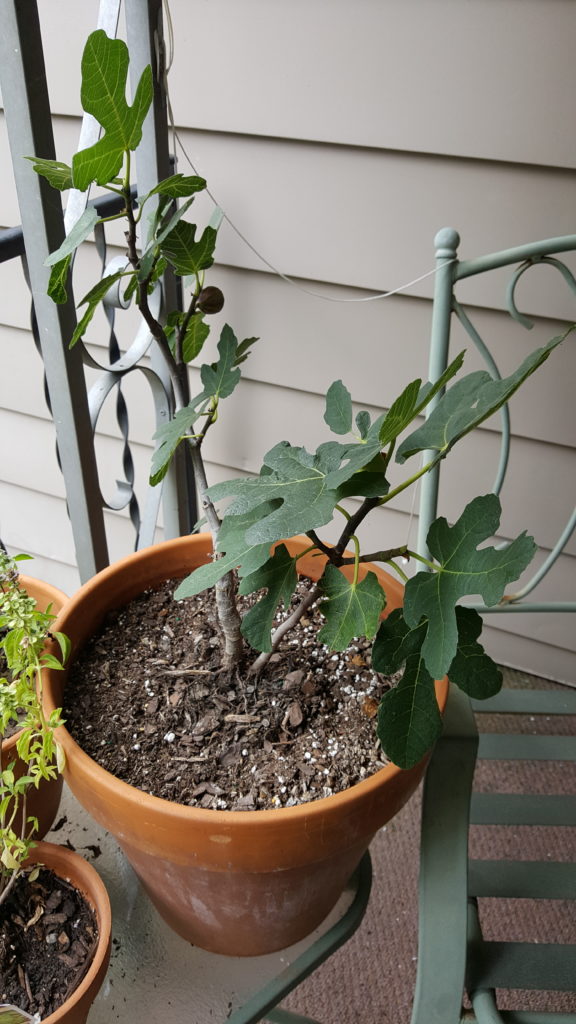
My first fig tree, 2016
Ever since 2016 when I saw a fig tree for sale at Lowes and convinced my mother to buy it, I have wanted to grow figs. Fresh figs are exotic to me. We always had dried figs when I was growing up. But the first time I had a FRESH fig was when I was in highschool, and I was immediately fascinated. Fresh figs are flavorful and juicy and nothing like their dried - and often hard - counterparts. The trouble is, they also like warm weather. Or at least, warmer winters than we get in west-central Illinois, USDA zone 5. That makes fig tree care a challenge.
Fortunately, there are cold hardy figs.
The Chicago Hardy Fig is usually listed as being hardy from zone 5 to 10. So as the name suggests, that means you should be able to grow it even as far north as Chicago.
But there is a caveat to the "hardiness" of Chicago Hardy Figs: the plant [i]should[/i] survive the whole winter, but it will usually die back. Generally when a plant is labeled "hardy in zone 5" that means it will fully survive the winter. In the case of Chicago Hardy Figs, their branches are only hardy down to 10 degrees Fahrenheit. This means that the tree will die back to its roots every year - even in a "mild" Illinois winter - and have to re-grow. It is only the roots which are hardy down to -20 degrees Fahrenheit (i.e. zone 5 winters).[source]
The good news is that the tree should produce figs on the new growth. But regrowing every year is, of course, a setback. You may only get one crop of figs, instead of the usual two per year.
The bottom line is that to grow a healthy fig tree in zone five, you need to protect it during the winter.
There are a few different options to protect your tree during the winter. One of them is to grow the fig tree in a pot, and then bring it inside. Another is to plant it in the ground, and wrap it up with burlap or another insulating material. And a third is to "heel in" your tree.
My first attempt to grow figs was in a pot, with the idea that I would bring the tree inside in the winter. This can be a very easy way to keep your fig safe over-winter, and care for your fig tree all year long. I have seen this method well for multiple years on end.
But there is a problem that comes with any potted plant that is kept outside in the summer, and brought in for the winter: bugs. The first year I brought my fig tree inside, it seemed to do really well. It survived the winter, and put on figs. But then the fruit began shriveling, and the tree started loosing its leaves. The cause? Mealybugs. I saved the tree (and you can read about it here), but pest problems remained a constant struggle.
The trouble is that pests, when they are outside, are naturally kept in check. But inside there is no cold weather or predators to keep them in check, and they can take over. So, if you are going to bring your fig tree inside, don't forget to treat it for bugs!
Fig trees are still trees, and as such, they will be happiest in the ground where their roots can stretch out. But remember, the hardiest of fig tree branches can still only take down to 10 degrees Fahrenheit. Even a mild zone five winter will have a cold night or two at or below that temperature. A cold winter will have multiple days below 0 degrees Fahrenheit.
So if you are going to try to keep your tree out all winter, they need a LOT of insulation. A sheltered southern-facing location would help. They will also need to be wrapped up in something insulating - such as burlap or bubble wrap, or both. Simply mounding leaves or mulch over their base will not be enough.
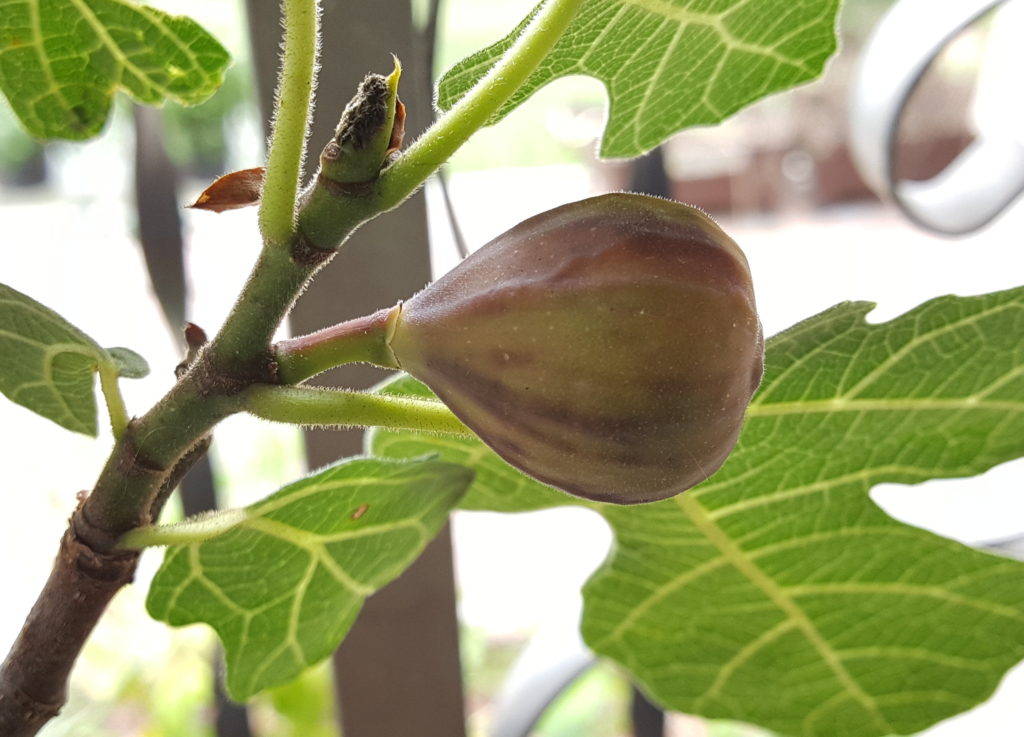
A delicious fig - the reward for good fig tree care
In the same vein as wrapping your tree, but even more protective, is "heeling in" the tree. Essentially, you dig a trench, and very carefully bend the tree over so that it is "laying down" in the trench. Then you cover it with mulch, sawdust, or the like.[source]
I have never been brave enough to try this method, but you can read about one person's experience with it here.
Winter care aside, figs are temperamental trees. Any discomfort is met with a giant temper tantrum.
And what does a tree temper tantrum look like? Why, dropping all its leaves, of course.
Is it too hot? The fig tree looses its leaves. Too cold? Drop those leaves. Too wet? Too dry? You guessed it... the leaves are falling.
But most of the time, when the fig's feelings are hurt, its a matter of water. Figs need a TON of water, which is a good argument for keeping them in the ground as opposed to a pot. If you do keep your fig in a pot, keep in mind that it will need to be watered every day in the summer. It may even need as much as a gallon or two of water a day once it gets big.
My first fig tree died a few years ago - I had to leave it overlong one winter, and that was too much stress for it. But that does not mean I have given up on figs! I have a new fig tree, in a large pot on my back patio. Come winter, I plan to wrap it up and put it in the garage for protection. I will update this post in the spring with my experience.
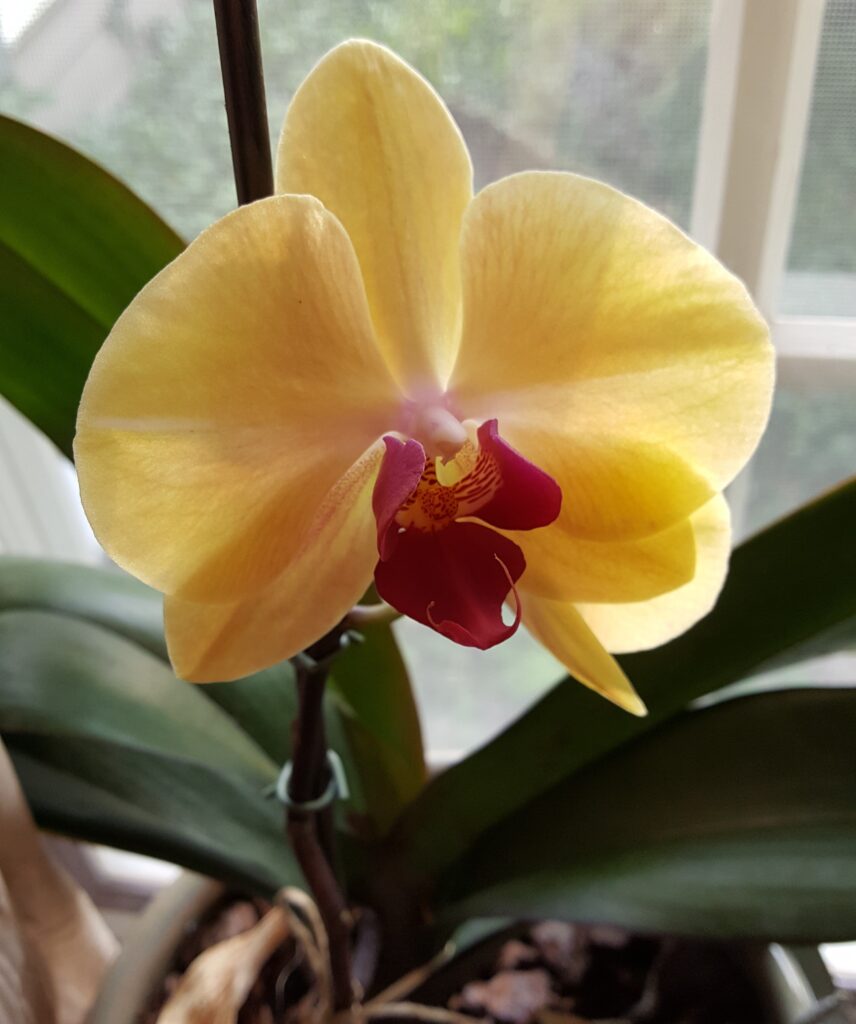
Orchids are undeniably beautiful flowers that exude an exotic and tropical allure. Their popularity is evident, as you can find them readily available in grocery stores across the nation. Despite their sophisticated appearance, orchids are surprisingly easy to care for, needing just weekly watering and the right amount of light.
However, the challenge begins once those stunning blooms fade. Orchids can look healthy, but refuse to grow a flower stalk for years. You might find yourself asking: do Phalaenopsis orchids rebloom?
At first, my orchids seemed stubbornly resistant to reblooming. I followed the basics — watering them regularly, fertilizing them, and moving them around the house to find the perfect window. Yet, nothing seemed to work. Then, one day, two beautiful new flowers appeared on my second-oldest orchid plant.
What was different? I had recently moved them to a west-facing window. There, they were getting bright indirect light for most of the day, with just a little bit of direct sunlight in the late afternoon. That bright mostly-filtered light was the thing they had been missing.
Phalaenopsis orchids, also known as "Moth Orchids," are epiphytes. This means they grow on other plants, typically big leafy trees that filter sunlight. Their native habitats are in regions like Indonesia, Southeast Asia, and Australia, where the climate is warm and humid.[source]
To keep orchids thriving, it’s essential to mimic their natural environment: providing bright, filtered light and the right humidity levels. You can maintain humidity through weekly watering and placing the pot on a gravel bed filled with water. While orchids might get a bit dry during the winter months (don’t we all?), they usually bounce back once conditions improve.
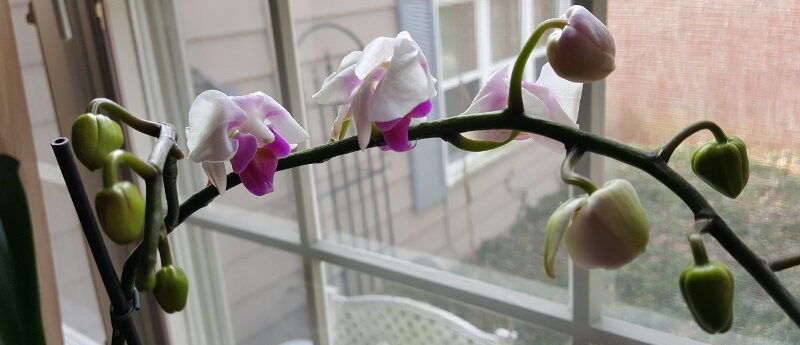
The trickiest part of orchid care is getting the light just right. Many guides suggest indirect light, but not all indirect light is created equal.
When I first started caring for orchids, I had only a north-facing window. Although it provided indirect light, it wasn’t strong enough to encourage blooming. My orchids remained healthy but flowerless.
After moving to a new place, I placed my orchids in a south-facing window. Unfortunately, the direct light was too intense, causing the edges of the leaves to turn brown from sunburn. Too much light can be just as detrimental as too little.
Finally, I settled my three Phalaenopsis orchids in a west-facing window. Here, they receive a bit of direct light in the late afternoon, filtered through the shade of several trees. This balance of light was perfect. Now, both of my older orchid plants have started growing flower stalks!
Getting Phalaenopsis orchids to rebloom can be a delicate balance of light, water, and temperature. For me, finding the right light was the breakthrough. If you’re struggling to get your orchids to rebloom, consider experimenting with different light exposures in your home. With patience and a bit of trial and error, you too can enjoy the beauty of reblooming orchids.
One of my dreams is to be able to grow fresh figs in west-central Illinois. Since figs love warmth, I have always kept my fig tree in a pot. In the summer, it sits on the back patio, luxuriating in the warm summer sun. In the winter, it comes inside to keep it from freezing.
Unfortunately, fig trees are not the only thing that likes being brought inside for the winter. The very first year I brought my fig tree inside, it became infested with mealybugs. The pests almost killed my tree, but I spotted the infestation in the nick of time. The fig tree went on to live for many more years.
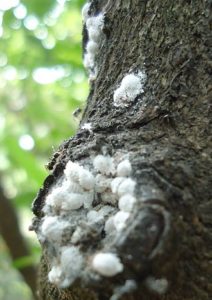
The mealybug infestation I suffered looked something like this, only in the soil instead of on the tree trunk. Picture courtesy of wikipedia.
The first symptom I noticed was a white "mold" at the base of the plant. A few days later, the leaves wilted. When I picked up the pot, a few bits of the white "mold" fell out of the drainage hole. I knew immediately that my tree was afflicted by something, but at first I thought it must be a fungus.
I took to the internet to identify the mold, and quickly realized that it was more likely to be a bug of some sort. Mealybugs, to be exact. They had infested the entire pot and laid their eggs all over the roots of my tree. The white "mold" was mealybug eggs.
Mealybugs are the bane of house plants everywhere. They feed on the soft new growth of plants - leaves, flower buds, stems. They suck out the sap, and leave behind discolored leaves. Then they lay their eggs in the soil of your pot, ensuring that you will continue to be plagued by their children.
I never caught sight of the bugs themselves (they are very small). But the Wisconsin Horticulture website describes them as:
"...pink, soft-bodied insects covered with a white, waxy, cottony material. The white “fluff” helps protect them from excessive heat and moisture loss. Unlike their relatives the scales, most species retain their legs throughout their life and can move around. Females are rounded, wingless, and about 1/16″ long."[source]
When they are outside, mealybugs will be naturally kept in check by natural predators and inclement weather. But inside, they thrive and reproduce at a fast rate. While there are male and female mealybugs, they can reproduce asexually. So you only need one mealybug in order to get an infestation.[source]
The best practice is to make sure there are no mealybugs in your plants or pots before you bring them inside. But what if you forgot, or have an infestation in spite of every precaution?

There is hope! My fig tree put on new growth after the mealybugs were removed.
If your tree has mealybugs on the stems or leaves, then you can simply cut them off. But if the bugs are attacking the root system - which they probably are if you can see them - that is not really an option.
The following procedure saved my plant:
I also sprayed the whole tree (roots and branches) down with Insecticidal Soap for Organic Gardening before replanting. This might have been overkill.
My tree was stressed from the procedure, and so dropped all of its leaves. Only brown buds were left.
A week later, the buds sprouted new green leaves. The fig tree bounced back, and flourished on the back porch for the rest of the year. The mealybugs did not kill the tree. The cleaning procedure did not kill the tree.
I have grown fig trees on and off ever since. The tree I saved from mealybugs lived for many more years. You can read more about the trials and tribulations of growing figs in west-central Illinois here.
Otherwise, I leave this story here in the hopes that someone else faced with a similar dilemma will be able to use some combination of the above methods to save their plant.
